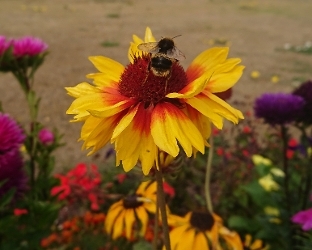Biodiversity - How You Can Help
The health of our natural surroundings has a proven effect on our own health, and diversity in our environment provides better resilience to climate change. So it's in everyone's best interests to do what we can to preserve and improve biodiversity. There are many things we can all do...

Home and Garden
If you're carrying out repairs or renovations to your house or garden, please consider the plants and animals that may be living there. You may be sharing your space with legally protected species (such as bats in roofs or trees), red-listed birds of conservation concern or other species (e.g. hedgehogs). More information about protected species can be found on the Nature Scot (opens new window) website.
You can help to enhance biodiversity in your own space by adding different features; from bat access slates on the roof or bird boxes on the house, to hedgehog holes in your fences or wild flowers and a raingarden (opens new window) in the garden. NatureScot has listed many different kinds of measures that we can use in our own houses and gardens - this list (opens new window) was created for people submitting planning applications, but it can be used as inspiration for anyone.
Recording
To monitor biodiversity (and to know whether it's in decline, stable or being improving) we need to know what exists and where. Help us to record species by observing what you see when you're out and about, and using the apps iRecord (opens new window) or iNaturalist (opens new window) to record plants, animals and fungi via your phone. If you use these apps, your information will be shared with experts who can verify your observations and add the information you collect to the national database. Information in the national database is used by scientists to research species and habitats, and can be used to help land managers (such as local councils) with management decisions, conservation measures, planning conditions, etc.
Practical conservation of public spaces
Join a local Friends of the Park group or the WLC volunteer ranger group. See Ranger Service or Parks and Gardens - Information and Events for information. There are also many other voluntary groups that carry out practical work outdoors in/around West Lothian, including The Conservation Volunteers (opens new window), Lothians Conservation Volunteers (opens new window), Scottish Wildlife Trust (opens new window), and The Green Team (young people) (opens new window).
Broaden your knowledge
Attend an event organised by the WLC Ranger Service, The Wildlife Information Centre, Lothian Amphibian and Reptile Group, Butterfly Conservation, Bumblebee Conservation Trust, Scottish Badgers, Scottish Wildlife Trust, RSPB, National Trust for Scotland, or numerous other organisations.
Pest Control
We share the planet with many living plants and animals. Make sure that whatever you think is a pest has a good reason for disturbance or extermination. Not all animals are pests just because they are in/near your house or garden. Are they definitely causing structural damage? Are they definitely a health and safety hazard? We ask that you do some research before eliminating them and choose your methods carefully.
Don't break the law!
Actions that damage habitats, or cause harm to wild plants or animals can be illegal. Some even carry a jail sentence. For more information and for advice about reporting a wildlife crime, visit the Police Scotland - Wildlife Crime (opens new window) web page.
Support an organisation
Join up and support organisations which help to protect, enhance or connect nature in Scotland.
Contact us
For more info on any of the above, the Ecology and Biodiversity team can be contacted at Ecology&Biodiversity@westlothian.gov.uk (opens new window)



